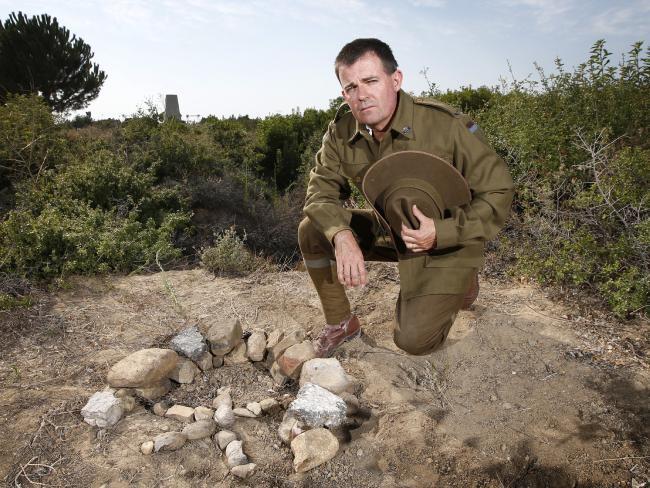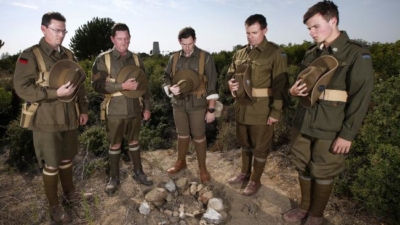THEY were 10 minutes into their daylong trek, within calling distance of the workers at the Lone Pine cemetery, when they stumbled on the remains.
Stuart Adamson, the Geraldton GP, spotted it first, a sliver blazing white under the scrub.
Then he spotted another. And another.
The group gathered to tally the discovery — two femurs, a tibia, an elbow, part of a pelvis and a skull cap. Nearby lay a large chunk of shrapnel.
It was 100 years since the battle of Lone Pine, lands that have been fossicked and analysed and virtually annexed as a little piece of Australia on the other side of the world.
Its surrounding ruts and gutters were once deep trenches, a Turkish stronghold.
Then it was charged, as one Anzac put it, “like a mob of ferrets in a rabbit hole”.
To this day the resulting chaos — combined with nature’s wild course of winds, erosion and bushfires — still muddle many untold secrets.
This one, it seems, this life was to be exposed by Adamson and a few mates traipsing through the scrub on their very personal mission to understand these battlefields better than most.
Yet it can never be told, not properly, anyway. There were no identity discs, no scraps of clothing.
They stared at the bones and wondered what to do. The group included Adamson’s son Harry, who at 14 is the same age as Gallipoli’s youngest Anzac death, James Martin.
He was an arresting sight, as was his father, given both were trekking in 11th Battalion replica uniforms.
Someone noticed the markers of the road, which snaked only 10m away, and would a couple of days later carry dozens of tour buses.
A decision was made. It followed the guidelines set out by officialdom for such finds. The group scraped a shallow grave.
Greg Cowle, whose grandfather was wounded in the August 6 charge of Lone Pine, suggested rocks in the shape of a crescent and star. Someone said an ode.
The Turkish tour guide said some words.
The funeral wasn’t much, but it was something, and certainly more than thousands received in 1915.
A forgotten soldier — probably a Turk, given the position on what was the third or fourth line of reinforcement trenches of 1915 — was, finally, remembered.
A road marker marks the spot near two pine trees.
The bones lie within throwing distance of the pits where Australia’s seven Victoria Crosses at Lone Pine were earned.
These were claimed in the madness after the initial charge, in the days and nights when bombs flew back and forth before they sometimes exploded in a man’s hands and face.
As Governor-General Sir Peter Cosgrove put it on Thursday, the intimacy of the savagery set Lone Pine apart: it was less modern warfare, more armed brawl.
Cheerier souls likened these duels to cricket catching contests.
Yet the so-called glory of a VC cost the lives of Alfred Shout and Alex Burton, and haunted the other recipients.
The underground horror show is hard to visualise now.
Cicadas find a chorus after the sun melts below the Aegean Sea each day. Gaba Tepe can be glimpsed below, its waters blue and inviting.
The sapping effects of the temperatures, then as now, remain much the same: though mindful of the lone pine tree’s symbolism, modern-day visitors value it as much as a solitary source of shade at this time of year.
Perhaps it’s easier to feel the terrors after dark, when the ghosts seem to urge you away.
When lights without obvious source dance on the road.
When dust suddenly kicks and whips at the windscreen. When you sit in the car and the door slams itself shut.
There could be another set of bones under here or over there.
As if to make the point, the Adamsons uncover another lost soul two days after the first find.
It is about 500m away. Father and son spot a humerus poking from pine needles. Careful examination also reveals a rib and part of a jaw.
Stuart Adamson does not seem at all surprised by his discoveries.
Perhaps he’s right not to be.
Gallipoli may be a national park, a nest of snakes and prickles.
Foremost, it is a boneyard. Within it, Lone Pine, as one Anzac wrote, will always stand as “the greatest bastard” of “all the bastards of places”.
Words by Patrick Carlyon, images by David Caird of the Hearld Sun.

Member of 11th Battalion Living History Unit Dr Stuart Adamson kneels next to the bush gravesite created for the remains of a human skeleton he found close to Lone Pine Cemetery. Picture: David Caird

